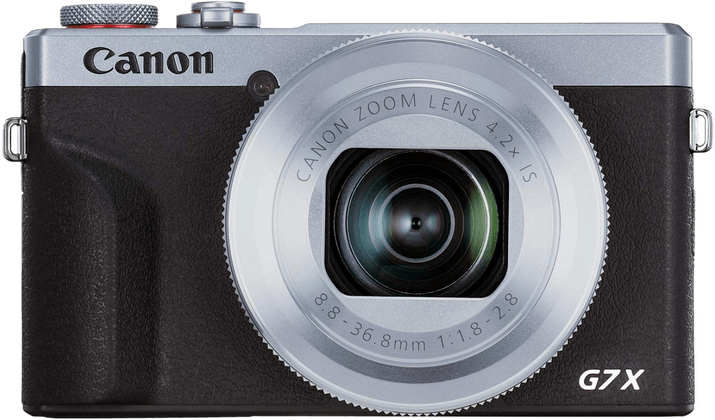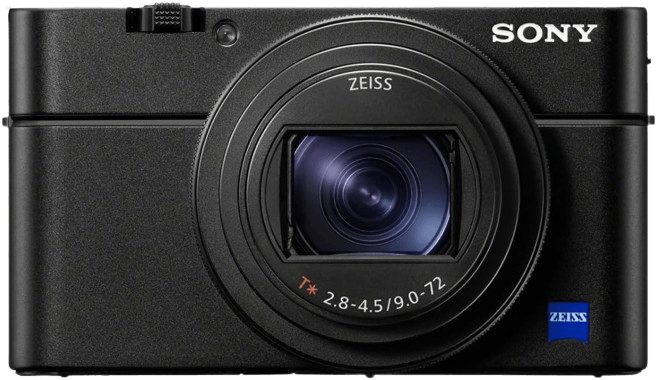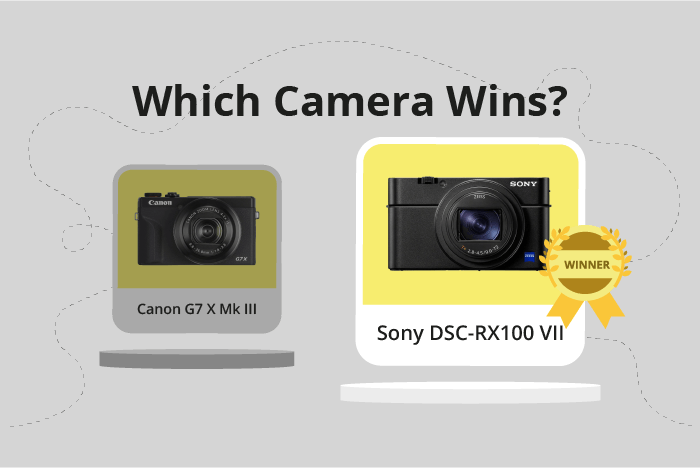Canon PowerShot G7 X Mark III vs Sony Cyber-shot DSC-RX100 VII Comparison
Canon PowerShot G7 X Mark III

Sony RX100 VII

The Sony Cyber-shot DSC-RX100 VII outperforms the Canon PowerShot G7 X Mark III by just one point, with scores of 60/100 and 59/100, respectively. Both cameras share similar specifications: they are compact, released in 2019, and have nearly identical size and weight. The Canon G7 X Mark III, however, has a lower launch price of $749 compared to the Sony RX100 VII’s $1200.
The Sony RX100 VII’s higher score indicates it offers better features and performance in certain aspects. On the other hand, the Canon G7 X Mark III’s lower price tag makes it a more budget-friendly option without sacrificing too much in terms of quality and functionality. Ultimately, the choice between these two cameras depends on individual preferences and budget constraints.
Canon PowerShot G7 X Mark III vs Sony Cyber-shot DSC-RX100 VII Overview and Optics
The Sony Cyber-shot DSC-RX100 VII outperforms the Canon PowerShot G7 X Mark III in optics with a score of 61/100 compared to 57/100. Both cameras share several common specifications, including 20-megapixel resolution, CMOS sensor type, 1″ sensor size, fixed lens mount, and image stabilization.
The Sony RX100 VII has a higher DXOMARK score for its sensor at 63, compared to the Canon G7 X Mark III’s score of 58. This indicates that the Sony camera offers better image quality and more accurate color reproduction. Additionally, the Sony RX100 VII is equipped with a Bionz X processor, which is known for its faster processing speeds and improved noise reduction, compared to the Canon G7 X Mark III’s Digic 8 processor.
On the other hand, the Canon G7 X Mark III has a higher shooting speed of 30 compared to the Sony RX100 VII’s shooting speed of 5. This means that the Canon camera can capture images more quickly, making it more suitable for fast-paced action and sports photography.
In terms of optics, the Sony RX100 VII is the better option due to its higher DXOMARK sensor score and more advanced processor. However, the Canon G7 X Mark III may be more suitable for those who prioritize fast shooting speeds. Both cameras offer competitive features and performance, with the final decision ultimately depending on individual preferences and photography needs.
Canon PowerShot G7 X Mark III vs Sony Cyber-shot DSC-RX100 VII Video Performance
The Canon PowerShot G7 X Mark III and the Sony Cyber-shot DSC-RX100 VII both receive a video score of 91/100, indicating that they have similar video capabilities. Both cameras have a maximum video resolution of 4K and max video dimensions of 3840 x 2160. Additionally, they both have a maximum video frame rate of 120fps and built-in time-lapse functionality.
Despite having the same video score, the Canon PowerShot G7 X Mark III has some advantages over the Sony Cyber-shot DSC-RX100 VII. The G7 X Mark III features a microphone input, allowing users to connect an external microphone for improved audio quality during video recording. This feature is especially useful for vloggers and content creators who require clear and crisp audio in their videos.
On the other hand, the Sony Cyber-shot DSC-RX100 VII also has its strengths. It offers a faster autofocus system, which can be beneficial for capturing fast-moving subjects in video. Additionally, the RX100 VII has a longer zoom range, providing more versatility in framing and composing shots.
Upon comparing the video capabilities of the Canon PowerShot G7 X Mark III and the Sony Cyber-shot DSC-RX100 VII, it is clear that both cameras have their unique strengths. The G7 X Mark III excels in audio quality with its microphone input, while the RX100 VII offers faster autofocus and a longer zoom range. Users should consider their specific needs when deciding between these two cameras, as both provide high-quality video performance.
Canon PowerShot G7 X Mark III vs Sony Cyber-shot DSC-RX100 VII Features and Benefits
The Canon PowerShot G7 X Mark III wins the features comparison with a score of 70/100, while the Sony Cyber-shot DSC-RX100 VII scores 68/100. Both cameras share several specifications, including a 3-inch screen size, touchscreen capabilities, flip screen, absence of GPS, and inclusion of WIFI and Bluetooth connectivity.
The Canon PowerShot G7 X Mark III outperforms the Sony Cyber-shot DSC-RX100 VII in screen resolution, offering 1,040,000 dots compared to the Sony’s 921,000 dots. This difference results in a sharper and clearer display on the Canon camera, providing a better user experience when reviewing images or navigating the camera’s settings.
On the other hand, the Sony Cyber-shot DSC-RX100 VII does not have any noticeable advantages over the Canon PowerShot G7 X Mark III in terms of features. Both cameras are evenly matched in most aspects, with the Canon’s higher screen resolution being the primary differentiating factor.
Considering each point, the Canon PowerShot G7 X Mark III is the better choice for users who prioritize a higher-quality screen. While the Sony Cyber-shot DSC-RX100 VII does not have any specific advantages, it remains a comparable option for those who may prefer the Sony brand or have other personal reasons for choosing it. However, it is essential to remember that features are only one aspect of a camera’s overall performance, and other factors such as image quality, optics, and video capabilities should also be taken into account when making a final decision.
Canon PowerShot G7 X Mark III vs Sony Cyber-shot DSC-RX100 VII Storage and Battery
The Sony Cyber-shot DSC-RX100 VII wins in the storage and battery comparison with a score of 29/100, while the Canon PowerShot G7 X Mark III scores 27/100. Both cameras have one memory card slot and offer USB charging. They also accept SD, SDHC, and SDXC cards, with the Sony additionally supporting Memory Stick Pro Duo cards.
The Sony RX100 VII outperforms the Canon G7 X Mark III in battery life, providing 260 shots compared to Canon’s 235 shots. This advantage allows users to take more photos before needing to recharge or replace the battery.
On the other hand, the Canon G7 X Mark III is compatible with UHS-I memory cards, which enables faster data transfer speeds. However, this advantage is not substantial enough to outweigh the Sony’s better battery life.
Considering the storage and battery aspects, the Sony Cyber-shot DSC-RX100 VII is a better choice due to its longer battery life and extra memory card compatibility. The Canon PowerShot G7 X Mark III falls slightly behind, but its compatibility with UHS-I cards offers a minor advantage in data transfer speed.
Canon PowerShot G7 X Mark III vs Sony Cyber-shot DSC-RX100 VII – Our Verdict
Are you still undecided about which camera is right for you? Have a look at these popular comparisons that feature the Canon PowerShot G7 X Mark III or the Sony Cyber-shot DSC-RX100 VII:
- Ricoh GR IIIx vs Sony Cyber-shot DSC-RX100 VII
- Canon PowerShot G7 X Mark II vs PowerShot G7 X Mark III
- Canon PowerShot G5 X Mark II vs Sony Cyber-shot DSC-RX100 VII
- Panasonic Lumix ZS200 (TZ200) vs Sony Cyber-shot DSC-RX100 VII
- Canon PowerShot G5 X Mark II vs PowerShot G7 X Mark III
- Canon PowerShot G7 X Mark III vs Panasonic Lumix ZS200 (TZ200)

